As a professional manufacturer of blow molds, we work in-depth with many clients who use high-end blow molding machines from brands like Tech-Long. Through our long-term service, we've found that even with top-tier equipment, various production issues will still arise if the mold's design and manufacturing fail to achieve the same level of precision and expertise. These problems not only impact efficiency but are also directly related to the final product's quality.
The core issues are typically concentrated in areas like bottle bottom deformation, bottle eccentricity, poor venting, inconsistent wall thickness, and system mismatches. As your mold partner, our value lies not only in understanding these problems but also in possessing a set of mature, field-proven solutions specifically for Tech-Long hot-fill systems.
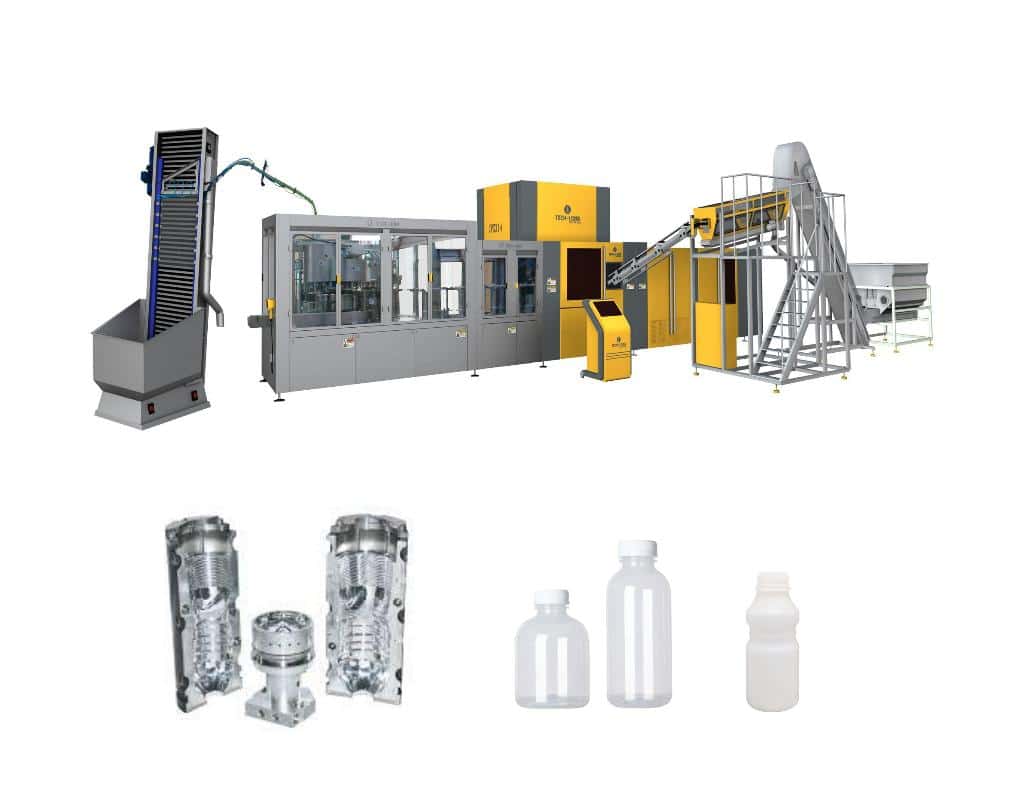
In this article, we will move beyond empty theories. I will leverage our practical experience from serving clients to analyze, one by one, the nine most common problems you'll encounter when using Tech-Long hot-fill molds. I will also provide a detailed explanation of how we solve these challenges for you through precision design, advanced processes, and professional service, ensuring your production line runs efficiently and stably.
Problem 1: Difficulty Controlling Bottle Bottom Deformation Under Heat
Customer Pain Point: Many clients report that when performing hot-fills with Tech-Long equipment (typically at temperatures above 85°C), the stability of the bottle bottom is a huge challenge. If the base mold structure is poorly designed or cooling is insufficient, the bottle bottom can easily "collapse," become concave, or asymmetrical, severely impacting the product's appearance and shelf presence.
Our Solution: We effectively solve bottle bottom deformation by optimizing the bottom's guide angles, re-designing the cooling channel layout, and reinforcing the center point design. This isn't just a simple adjustment; it's a systematic optimization方案 based on thermodynamics and structural mechanics.
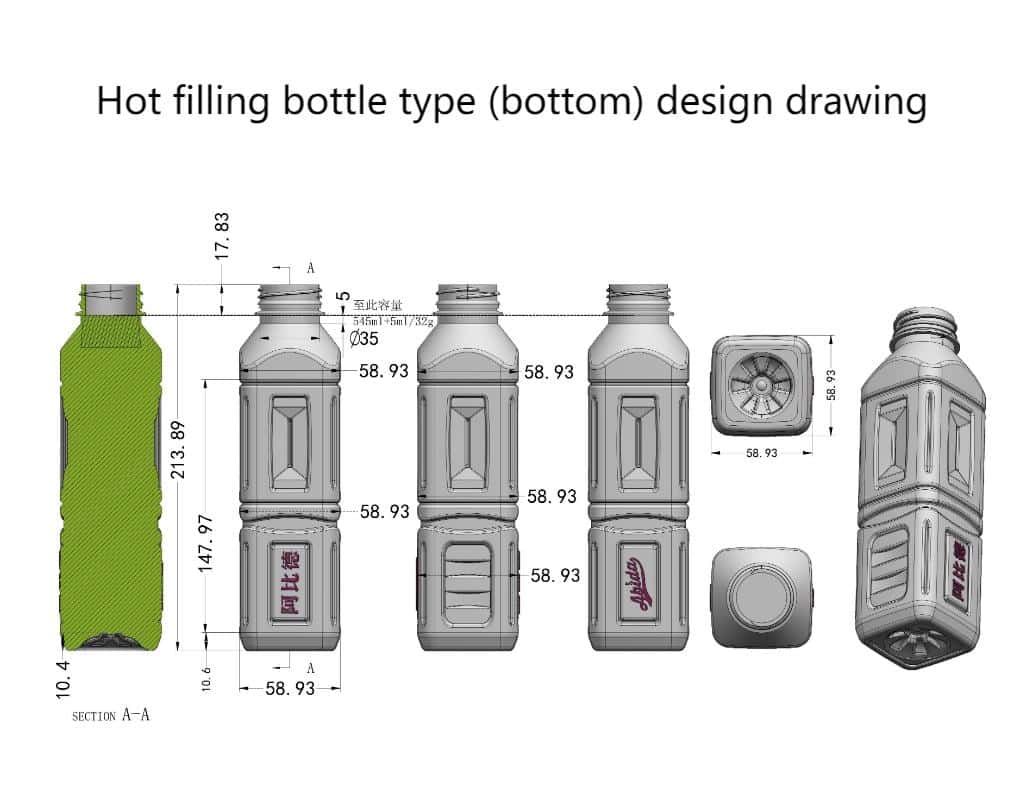
The essence of the hot-fill process is to "heat-set" the PET bottle, allowing it to withstand subsequent hot liquid filling without deforming. As the supporting foundation of the entire bottle, the thermal stability and structural strength of the base are critical. When hot liquid is injected, the internal pressure and temperature rise sharply. At this moment, if any area of the base has insufficient crystallinity or structural support, deformation will occur at the weakest point.
How We Solve It at the Source?
Our design philosophy is "proactive prevention" rather than "passive remedy."
- Optimizing Bottom Geometry: We abandon simple concave designs in favor of "five-point" or "petaloid" mechanical structures with reinforcing ribs. At the same time, we meticulously design the bottle's base angles and standing feet to form a stable support plane, evenly distributing pressure from the top. This greatly enhances the base's compressive strength.
- High-Density, Conformal Cooling Channels: Insufficient cooling is the main culprit behind base deformation. Our custom blow molds use CNC machining to create cooling channels that perfectly conform to the complex curves of the bottle base. Compared to traditional straight-drilled holes, these "conformal channels" have a larger contact area and no cooling dead spots, ensuring that heat is rapidly and uniformly carried away from the base the moment it's formed, forcing it to crystallize and set quickly. This is crucial for fixing common PET blow molding defects.
| Design Aspect | Flaw in Conventional Design | Our Optimized Solution |
|---|---|---|
| Base Structure | Simple concave/flat, stress concentration | Mechanical structure with ribs, disperses stress |
| Cooling Design | Straight-drilled channels, cooling blind spots | CNC-machined conformal channels, uniform & efficient cooling |
| Center Support | Weak support point, prone to collapse | Reinforced center point design, provides rigid support |
Problem 2: Stretch Rod Misalignment Causes Eccentric Bottles
Customer Pain Point: The produced bottles are thick on one side and thin on the other, a problem we call "eccentricity." Not only is such a bottle visually unappealing, but more importantly, its physical properties (like top-load strength and barrier properties) are significantly compromised, posing a serious safety risk. This problem is particularly prominent in rotary hot-fill machines like Tech-Long's.
Our Solution: We customize the stretch rod's diameter and length according to the client's specific bottle shape and use professional tools for precise calibration during mold installation, ensuring the alignment accuracy between the stretch rod and the mold center reaches the micron level.
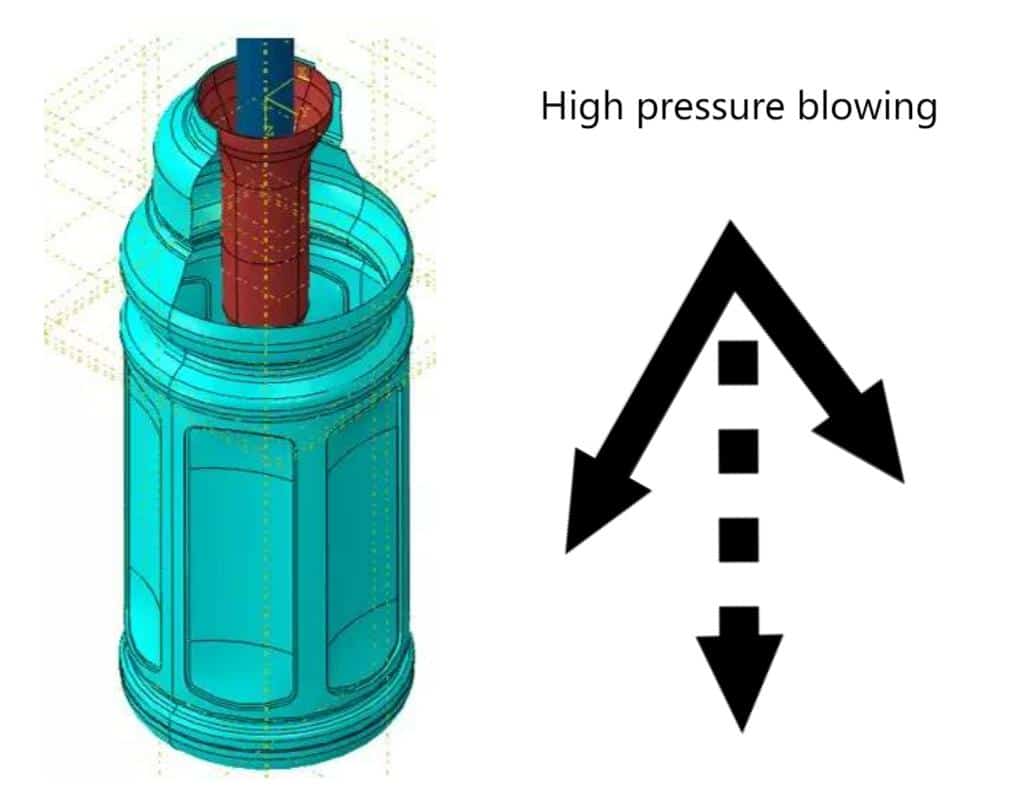
The root cause of bottle eccentricity is that the preform is not perfectly centered in the mold cavity during the axial stretching phase before blowing. The stretch rod is the key component that performs this action. If the rod deviates at all during its high-speed descent, or if its diameter doesn't match the preform opening, causing it to wobble, the preform will be pushed to one side. In the subsequent high-pressure blowing, the side closer to the mold wall stretches less and becomes thick, while the side farther away stretches more and becomes thin.
The Art of Precision Matching and Calibration
Solving the eccentricity problem requires precise work in two areas:
- Stretch Rod Customization: We do not use "one-size-fits-all" stretch rods. We design and manufacture rods with a perfectly matched tip shape, diameter, and length based on the inner diameter and bottom shape of the client's preform. A well-matched rod can self-guide and stabilize as it enters the preform, which is the first line of defense against misalignment.
- Strict Installation Calibration: When installing the mold on the client's bottle blowing machine, our technicians use specialized centering tools and gauges to repeatedly adjust the stretch rod's fixed position, ensuring its trajectory perfectly coincides with the mold's geometric centerline. For high-speed rotary equipment, we understand that a tiny error can lead to a huge discrepancy. A seemingly minor detail is a critical, make-or-break chapter in our PET bottle mold design guide.
Problem 3: Poor Venting Causes Defects or Flash
Customer Pain Point: The bottle body, especially in complex areas like logos, reinforcing ribs, or the base, shows incomplete formation, blurry details, burnt spots, or thin seams of excess plastic ("flash") on the mold's parting line. These issues often point to the same root cause: poor mold venting.
Our Solution: We use advanced airflow analysis software to simulate the blowing process and design an optimal venting solution accordingly. By strategically placing micron-level vents in critical areas, we can ensure that the air inside the cavity is smoothly evacuated within ten-thousandths of a second.
The moment high-pressure air inflates the PET preform against the mold walls, the air already inside the cavity must escape immediately. If the vent channels are obstructed, this air gets violently compressed, causing its temperature to skyrocket (the diesel effect), which can scorch the bottle's surface. At the same time, the trapped air forms a "cushion" that prevents the PET material from fully conforming to the mold wall, resulting in unclear details. "Flash" occurs when this high internal cavity pressure tries to squeeze plastic out through the parting line seams. For high-hardness hot-fill mold steels like S136, venting design is even more challenging.
Our Systematic Venting Strategy
We view venting design as the mold's "respiratory system," which must be scientifically planned.
- Digital Simulation First: During the design phase, we use software simulation to accurately predict which areas are most likely to form "air traps" during the blowing process.
- Multi-Layered Venting Structure:
- Parting Line Vents: We optimize the depth and length of vent grooves along the parting line, which is the most basic form of venting.
- Vented Inserts: For extremely complex areas like logos and text, we use an insert structure and design 360-degree vent channels at the insert's seams.
- Micro-Vents: On flat surfaces that are still prone to trapping air, we use laser or EDM processes to create vents with a diameter of only 0.05-0.1 mm, achieving the goal of "venting air without leaking plastic."
Problem 4: Inconsistent Wall Thickness in the Shoulder or Bottom
Customer Pain Point: The produced bottles either have shoulders that are too thin and prone to breaking, or bases that are too thick and waste material. An undesirable wall thickness distribution directly affects the bottle's performance and cost. This problem is related to preform heating, stretching speed, and mold design.
Our Solution: During the mold design phase, we fully consider the heating zone distribution and lamp angles of the Tech-Long machine. Through subtle adjustments to the mold cavity, we "guide" the preform material to achieve an ideal distribution during stretching, ensuring all areas are heated and formed uniformly.
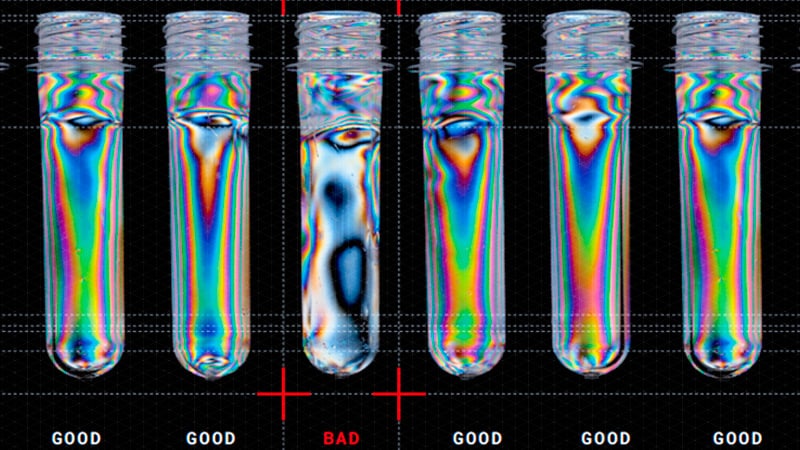
Achieving a consistent wall thickness is a systematic engineering feat. Before entering the mold, the preform is subjected to "differential heating" by multiple sets of infrared lamps in an oven. For example, the section that will become the shoulder needs more heat to achieve a larger stretch ratio, while the neck finish area needs to remain cool and rigid. If the mold's design doesn't match this heating scheme, problems will arise.
The Perfect Marriage of Design and Process
Our role is to bridge the gap between the "heating process" and "mold design." We will ask the client for their machine's heating parameters and may even request preform samples for blowing tests before designing, to obtain its natural stretching characteristics under specific heating conditions. Then, when designing the mold cavity, we intentionally make micro-adjustments in certain areas. For instance, if we find the shoulder tends to be too thin, we might design the corresponding area of the mold to be slightly "fuller," reserving reasonable space for material flow and filling. This approach of designing based on process feedback can fundamentally solve the problem of uneven wall thickness. We also provide advice on the preform itself, including how to choose the right preform neck size, because a good preform is the foundation of a good bottle.
Problem 5: Misfit Between Mold and Blowing System
Customer Pain Point: This is the biggest worry for any production manager—a brand new, expensive mold arrives at the factory, only to find it doesn't fit! The guide rails are wrong, the water and air connections don't line up, and installation is difficult or even impossible, causing serious production delays.
Our Solution: We build our molds strictly according to Tech-Long's original factory system specifications. We maintain and continuously update an installation data library for mainstream blow molding machines (including Tech-Long), ensuring that every interface on every mold we produce is identical to the factory standard, achieving true "plug-and-play" capability.
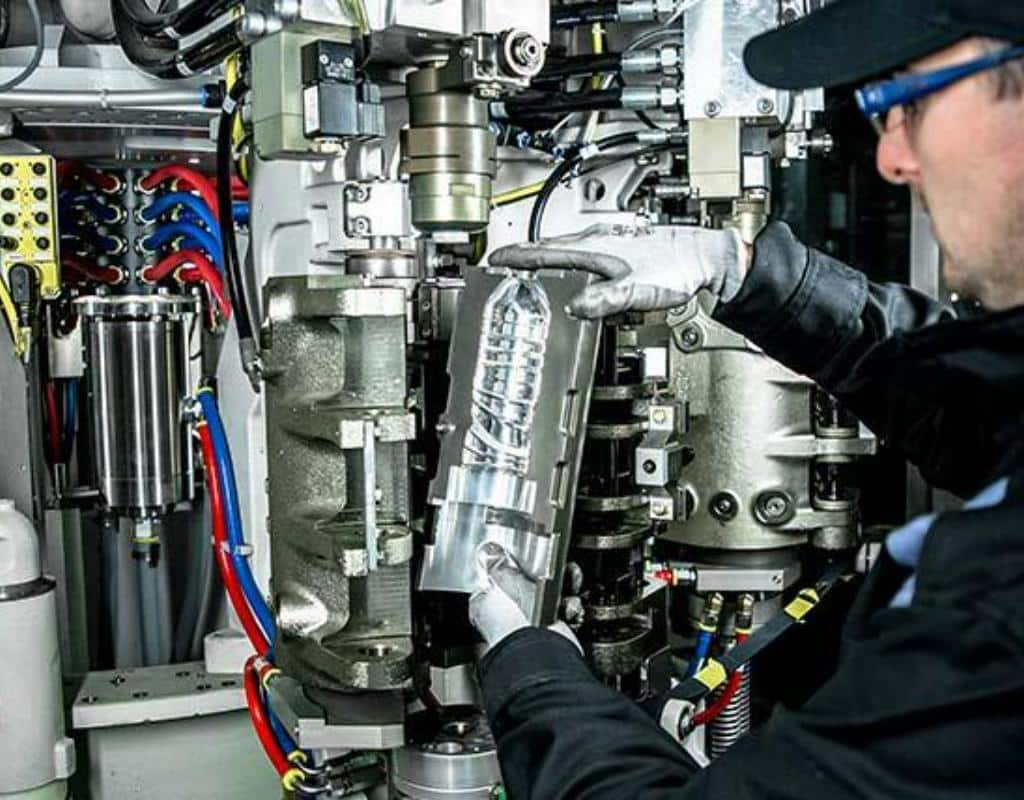
A mismatch between the mold and the machine is a basic but fatal error, exposing a severe lack of professionalism from the mold supplier. For the client, it means catastrophic downtime and incalculable losses. Every interface, every dimension, must be 100% accurate.
How We Ensure a 100% Fit?
We have invested significant resources to build a comprehensive "Blowing Machine Compatibility Database."
- Full Coverage of Critical Dimensions: Our database includes detailed installation dimensions for brands like Tech-Long, including but not limited to: mold locating hole positions, guide rail width and height, precise clamping structure shape, lock depth, and the specifications, threads, positions, and quantity of cooling water and air line interfaces.
- A "Foolproof" Installation Experience: Our goal is that when the client's on-site technician receives our mold, they can install it easily and quickly without any need for secondary modifications or adjustments, just like installing an original factory mold. This ultimate pursuit of detail for a perfect mold and blowing machine match is the foundation of the trust we build with our clients.
Problem 6: Mold Material Unsuitable for Hot-Fill Use
Customer Pain Point: Some suppliers, in an effort to cut costs, might recommend using 6061 or 7075 aluminum, or even standard P20 steel, to make hot-fill molds. The result is that the mold starts to corrode, rust, or even deform after a very short period of use, severely impacting mold life and product hygiene.
Our Solution: We insist on using imported S136 stainless steel for all hot-fill molds. This material is the industry-recognized best choice for handling high-temperature, high-pressure, and high-humidity environments. We never compromise on materials, as this is the fundamental guarantee for our clients' product quality and long-term investment.
The material is the "DNA" of the mold. The working environment for a hot-fill mold is extremely harsh: it repeatedly withstands the impact of high temperatures (85°C+) and high pressure (40 Bar), while also dealing with moisture from the cooling channels. In this environment, aluminum will deform due to insufficient strength, and ordinary steel will rust quickly.
Why S136 Steel is the Only Choice
| Material Type | 7075 Aluminum | P20 Steel | S136 Stainless Steel (Our Choice) |
|---|---|---|---|
| Corrosion Resistance | Very Poor. Oxidizes and pits quickly. | Poor. Prone to rust without plating. | Excellent. High chromium content prevents rust. |
| Hardness/Wear Resistance | Low. Easily dented or scratched. | Medium. Wears down over time. | High. Resists wear for millions of cycles. |
| Thermal Stability | Poor. Can deform under high heat. | Fair. | Excellent. Maintains shape at hot-fill temps. |
| Polishability | Good, but doesn't last. | Fair, requires chrome plating for best finish. | Superb. Can be polished to a mirror finish and holds it. |
| Mold Lifespan | Short (typically <500k cycles) | Medium (approx. 1-3M cycles) | Long (can exceed 5M+ cycles) |
Therefore, investing in an S136 blow mold is actually an investment in your future years of stable production and high-quality products. It's a choice with an extremely high return.
Problem 7: Inaccurate Engraving or Logo Deformation
Customer Pain Point: The elegant embossed logo on the design draft looks blurry, stretched, or inconsistent in depth on the actual produced bottle, severely damaging the brand image.
Our Solution: We provide multiple engraving depth and process testing options. Before formally machining the steel, we optimize the engraving parameters by combining them with the flow and stretch characteristics of the plastic during the blowing process, ensuring the final logo on the bottle is visually clear, three-dimensional, and resistant to deformation.
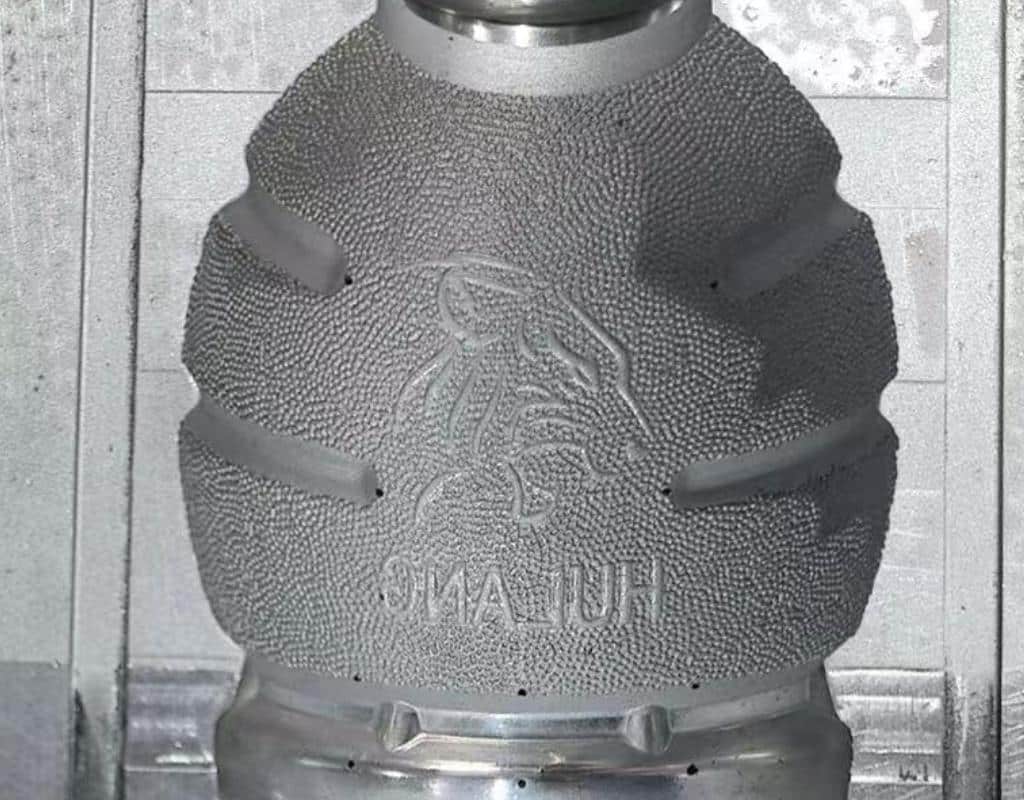
The embossed effect on a bottle is created by engraving its negative image into the mold cavity. However, during blowing, the hot, soft plastic doesn't just press into the engraving; it flows and stretches over it. This dynamic movement can easily distort fine details if the engraving is not designed correctly. For example, a logo in a high-stretch area will need to be engraved deeper and thicker to compensate for the thinning and lightening caused by stretching.
From "Engraving" to "Designing"
We don't see this as a simple engraving task, but as a "redesign of the visual effect."
- Stretch Ratio Compensation: We analyze the stretch ratio in different areas of the bottle and apply a pre-emptive "inverse deformation" to the engraving's outline.
- Depth and Draft Angle Testing: We provide 3D printed samples with different depths and draft angles, allowing the client to physically touch and see the effect of various options to select the best one.
- Process Selection: Based on the logo's complexity, we choose the most suitable processing method, whether it's high-speed CNC precision carving or EDM, to ensure even the finest details are perfectly reproduced.
Problem 8: Mold Cooling Circuit Not Optimized
Customer Pain Point: The production cycle time just won't come down. Even with the chiller running at maximum capacity, the bottles still feel a bit soft when they come out. This usually means the mold's internal "blood vessels"—the cooling circuit—have a problem.
Our Solution: We use a full-flow CNC machining process to create the water channels, increasing the heat transfer area and water flow velocity through a more optimized channel layout. This effectively boosts production efficiency and bottle dimensional stability.
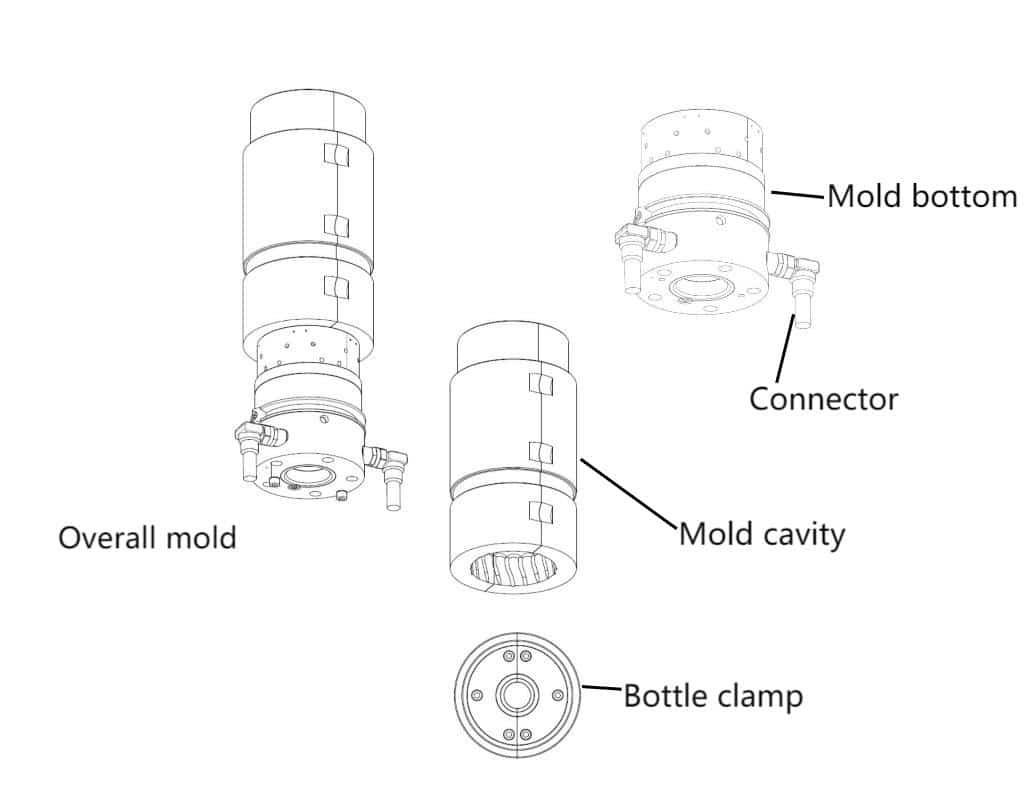
Cooling is the longest phase in the blow molding cycle. Every 10% increase in cooling efficiency can potentially increase your production efficiency by over 5%. An obstructed or poorly designed water circuit is like a blocked artery; even if the heart (the chiller) is strong, it can't deliver cooling capacity effectively where it's needed.
The Pursuit of Ultimate Cooling Efficiency
We create high-efficiency cooling systems in the following ways:
- High-Flow Design: We design cooling channels with larger cross-sectional areas and use smooth transitions at bends to reduce water resistance, ensuring more cooling water flows through per unit of time.
- Turbulent Flow Design: We strategically place "baffles" or use spiral channels to disrupt the stable "laminar flow" and create "turbulent flow." The heat exchange efficiency between water in a turbulent state and the mold steel is several times higher than in a laminar state.
- Direct-to-Hotspot: Our channel design gets as close as possible to the cavity surface, especially in heat-concentrated areas like the base and neck, to carry away heat at the earliest moment. We even use high-conductivity beryllium copper alloy inserts to tackle the most stubborn hotspots.
Our Promise: Mold Interface Matches Tech-Long Originals – 100% Installation Fit
This is our most solemn promise to every client and the ultimate reflection of our professionalism. Behind this promise is our accumulated experience in solving real-world client problems.
To this day, I still clearly remember our first cooperation with a major client in Bangladesh years ago.
They were a well-known local beverage company using a Tech-Long hot-fill production line. At the time, they were skeptical of our capabilities as a third-party supplier. After all, a set of hot-fill molds is a significant investment, and the loss would be enormous if it didn't fit. During more than a month of technical communication, they repeatedly confirmed every single detail.
After the client finally decided to order all 11 sets of molds, to completely eliminate their concerns and as a way for us to demonstrate our sincerity and technical confidence, I negotiated a special production process with them: We would first concentrate all our resources to complete the production and delivery of the first set of molds. The client would conduct comprehensive testing on this set with their Tech-Long machine. Only after they provided written confirmation that the performance, fit, and produced bottle quality of the first set were fully qualified would we then start production of the remaining 10 sets.
This plan gave the client peace of mind and proved to them our absolute confidence in our own technology. In the end, that first mold was installed successfully in their factory on the first try, and the bottles it produced met their quality standards completely. The client was very satisfied, and we then smoothly completed the production of all remaining molds.
This experience taught us how important it is to have precise factory data and to provide service that exceeds client expectations. Today, we have built a massive database containing the original mold structure data for over 80% of the world's mainstream blow molding machines, including Tech-Long. We can ensure that every mold we provide you—its locating holes, guide rails, clamping structure, water and air line interfaces—fully matches the original, requiring no rework or machine modification from you and helping you achieve seamless "production-ready on arrival."
Conclusion
Solving the common issues with Tech-Long hot-fill molds requires systematic thinking that goes beyond the mold itself, as well as deep industry experience. We are committed to being your most reliable partner, providing you with mold solutions that are impeccable from design to production, from performance to fit.
Frequently Asked Questions (FAQ)
1. Why does my hot-fill bottle still deform at the bottom after stacking, even though it's a hot-fill bottle?
This is likely due to insufficient "post-crystallization" of the bottle base. This means that although the bottle appears set when it leaves the mold, its internal crystallinity has not yet reached its maximum level. It undergoes secondary deformation under subsequent storage pressure and temperature changes. Our solution is to ensure the base reaches a higher degree of crystallinity before demolding by optimizing mold cooling and extending in-mold pressure hold times, thereby enhancing its long-term stability.
2. How do you guarantee that the custom stretch rod for my special bottle shape is correct?
Before designing the stretch rod, we will ask for your preform's 2D drawings and physical samples. We will obtain all internal dimensions of the preform through 3D scanning and precise measurement. Combined with your bottle design, we simulate the stretching process with software to determine the optimal stretch rod length, diameter, and tip shape. All stretch rods undergo strict dimensional inspection before delivery.
3. If my bottle has a very fine frosted or textured effect, can you achieve it?
Absolutely. For fine surface effects, we typically use precision etching or laser processing techniques. We will first create samples with different effects on small pieces of S136 steel for you to select and confirm. After getting your approval, we will then process the entire mold set to ensure the final product's texture perfectly matches your design requirements.
4. What is your mold delivery time? Is it faster than the original manufacturer?
Since we specialize in mold manufacturing and have a highly optimized process, in most cases, our design and manufacturing cycle is shorter than that of the equipment's original manufacturer, typically around 30-45 days, depending on the mold's complexity. We can help you save precious time-to-market while guaranteeing quality.
5. After installing your mold, will I need to make extensive adjustments to my existing blow molding machine parameters?
Generally, no. Our design goal is to be compatible with your existing process parameters as much as possible. Since our molds may be superior to your existing ones in terms of cooling efficiency and venting performance, you usually only need to make minor tweaks to your original parameters. You might even be able to further optimize parameters (like shortening the cooling time) to increase production efficiency. During installation and commissioning, our technicians will also provide professional parameter setting recommendations.
🔗 Learn More about Blow Molding Technology
Blow Molding – Wikipedia
A comprehensive overview of various blow molding processes, including extrusion, injection, and stretch blow molding.Injection Molding – Wikipedia
Important for understanding the production of preforms used in stretch blow molding.Stretch Blow Molding – Wikipedia
Explains how PET bottles are formed through axial and radial stretching processes.PET Bottle – Wikipedia
Background information on the materials and properties of typical PET bottles.Design of PET Bottles – Wikipedia
An introduction to the design considerations and geometry used in PET bottle manufacturing.
🔗 Related Pages on Our Website
Automatic Blow Molding Machines – iBottler
Discover our full range of customizable automatic PET bottle blow molding machines.Blow Bottle Mold – iBottler
Explore our precision blow molds designed for PET and PP bottles.Preform Mold – iBottler
Learn more about our high-precision preform molds suitable for various injection molding machines.PET Wide Mouth Jar Project Starter Guide: Equipment, Molds & Process Explained
Worried About Blow Mold Fit? We Have Mounting Dimensions for 80% of Blow Molding Machines Worldwide
Can One Semi‑Automatic Blow Molding Machine Produce All Bottle Sizes? Here’s Why Not
Why Do Krones Blow Molding Machine Users Come to Us for Their Molds?
Why Do PET Preforms Come in Different Colors? Function, Application, and Production Tips
How to Set Parameters for 600ml Bottles on a Semi-Automatic PET Blowing Machine?
From 3D Printed Samples to Production: How Can You Rapidly Validate Blow Mold Designs?
How to Choose the Right Preform Neck Size for Your PET Bottle Project
Share:
- Click to share on WhatsApp (Opens in new window) WhatsApp
- Click to share on Facebook (Opens in new window) Facebook
- Click to share on X (Opens in new window) X
- Click to share on LinkedIn (Opens in new window) LinkedIn
- Click to email a link to a friend (Opens in new window) Email
- Click to share on Tumblr (Opens in new window) Tumblr
